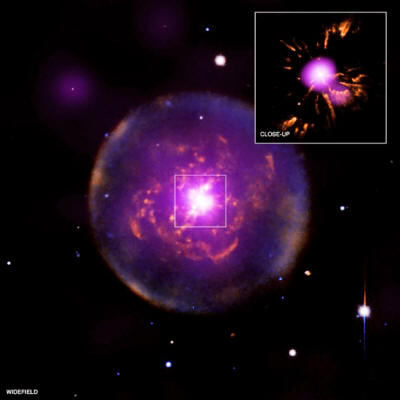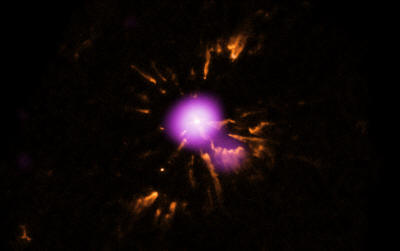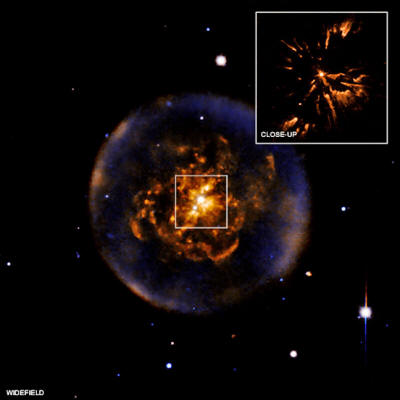|
November 15, 2012
Images of the planetary
nebula Abell 30, (a.k.a. A30), show
one of the clearest views ever obtained of a special phase of
evolution for these objects.
These crises culminate in the star
expanding a hundred-fold to become a red giant.
This composite image shows a planetary nebula, Abell 30, located about 5500 light years from Earth. Image credit: NASA/CXC/IAA-CSIC/M.Guerrero et al
Eventually the outer envelope of the red giant is ejected and moves away from the star at a relatively sedate speed of less than 100,000 miles per hour.
The star meanwhile is transformed from a cool giant into a hot, compact star that produces intense ultraviolet (UV) radiation and a fast wind of particles moving at about 6 million miles per hour.
The interaction of the UV radiation and
the fast wind with the ejected red giant envelope creates the
planetary nebula, shown by the large spherical shell in the bigger
image.
The sequence of events - envelope
ejection followed by a fast stellar wind - is repeated on a much
faster scale than before, and a small-scale planetary nebula is
created inside the original one. In a sense, the planetary nebula is
reborn.
Optical data from Chandra, XMM-Newton, HST and KPNO.
Image credit: NASA/STScI
The cloverleaf pattern of knots seen in
both images, correspond to the recently ejected material. These
knots were produced much more recently, as they have an observed age
of about 850 years, based on observations of their expansion
using the HST.
The cause of the point-like X-ray
emission from the central star is unknown.
These observations of A30, located about
5,500 light years away, provide a picture of the harsh environment
that the solar system will evolve towards in several billion years,
when the sunís strong stellar wind and energetic radiation will
blast those planets that survived the previous, red giant phase of
stellar evolution.
A new study of A30, using the
observatories mentioned above, has been reported by an international
team of astronomers in the August 20th, 2012 issue of The
Astrophysical Journal.
|



